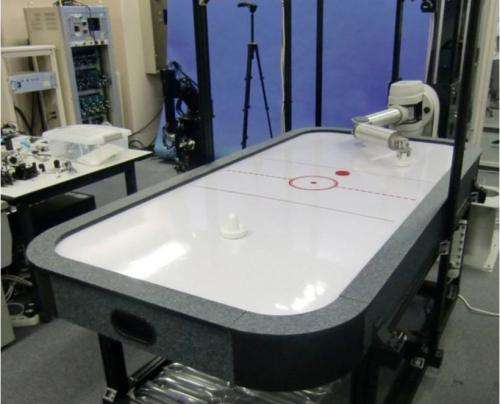(Phys.org) —Robots playing air hockey can play strategically as a result of work by researchers in Japan at Chiba University's Namiki Lab. The system they constructed consists of an air-hockey table, a Barrett four-axis robotic arm, two high-speed cameras, and an external PC. This is not the first air hockey playing robot. Back in 2008, for one, there was the Nuvation Air Hockey robot that grabbed admirers. This was an industrial robot equipped with an optical sensor programmed to follow and react to a moving object. The differentiator with the Namiki Lab robot is that this one is able to strategize playing against its human opponent. Professor Akio Namiki and his group have designed a robot that can shift its strategy based on the opponent's playing style. The robot isn't just playing but is making its plays specifically against the opponent in any one game.
The researchers have written that their motive in developing the air hockey system was "to develop the technology of high-speed human interactive robot in which the robot reads the opponent's intention and moves in response to the opponent's motion and human purpose expectation."
The research focus of Prof. Namiki generally is on the robot hand, grasping, dynamic manipulation, visual feedback control, sensor fusion, and sensory-motor fusion. The report in IEEE Spectrum describes how the university researchers programmed the robot with a three-layer control system. Layer number one takes care of motion control at the hardware level. A second layer decides if the robot should hit the puck, defend the goal, or stay still. The robot chooses the right move to counter the incoming trajectory of the puck. The third layer deal with a longer-term strategy.
"The robot observes the speed and position of the player's paddle in relation to the puck. This data can be described by what is known as a Motion Pattern Histogram (MPH). The robot uses this data to estimate whether its opponent is playing aggressively or defensively. Over the course of a game, the robot can detect these MPHs in real-time and compare them with reference patterns to help it figure out what you're doing."
According to the team, their experiments showed that the robot was able to figure out playing behaviors. The Chiba researchers, along with Professor Namiki, are Sakyo Matsushita, Takahiro Ozeki, and Kenzo Nonami. They are authors of "Hierarchical Processing Architecture for an Air-Hockey Robot System." They presented this paper last month at the IEEE International Conference on Robotics and Automation (ICRA) in Germany.
More information: Project site: mec2.tm.chiba-u.jp/~namiki/res … AirHockey/index.html
via IEEE Spectrum
© 2013 Phys.org























